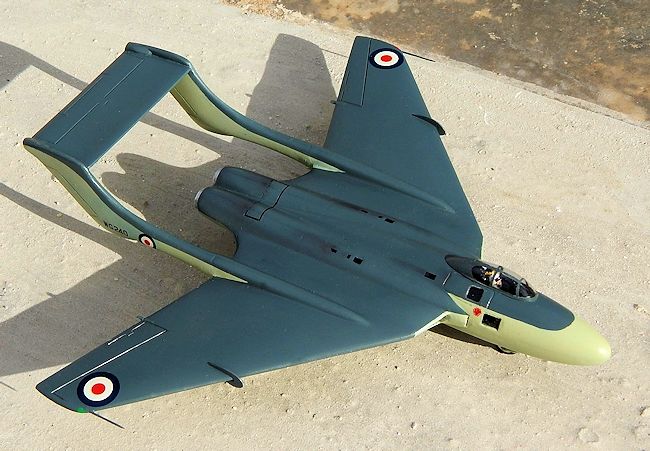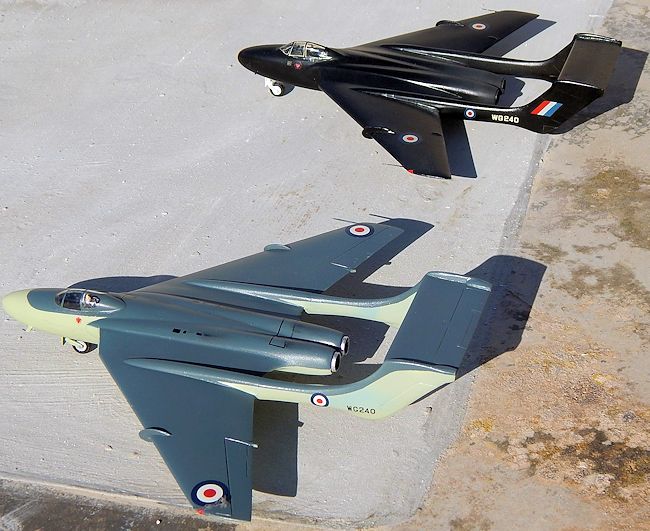
Project X 1/72 DH.110
| KIT #: | ? |
| PRICE: | 12.00 Euros |
| DECALS: | One option |
| REVIEWER: | Carmel J. Attard |
| NOTES: | Vacuform with metal parts |

| HISTORY |
The DH-110 was designed originally to an RAF requirement for a night and
all-weather fighter that was later fulfilled by the Gloster Javelin. Later the
DH-110 prototypes were Ďnavalisedí and the type was adopted by the Royal Navy in
a similar role. The kit provides for the second prototype aircraft (WG240) at
the time of the Farnborough Air Show in September 1952 when it was finished
overall gloss black with white serials appearing
on booms and under wings.
The pilotís cockpit was offset to port to provide sufficient working space for
the radar operator/navigator below and behind on the starboard side. Radar
equipment included hydraulically driven scanner in a fibreglass radome in the
nose.
 The first prototype WG236 flew for 46 minutes at Hatfield on September 26th
1951 piloted by John Cunningham and first exceeded the speed of sound in a
shallow dive on April 9th 1952. The second prototype WG240 flew on
July 25th of that year .On September 6th this aircraft
went unserviceable and the first prototype aircraft WG236 was substituted in the
air display, flown by John Derry and his test observer Tony Richards. Both
crewmembers were killed when WG236 broke up in flight during a demonstration
following a catastrophic wing failure. The effect of extreme acceleration and
sharp roll at low level caused the aircraft to break up in air over the watching
crowd. Also losing their life were 29 spectators and many others were injured
when one of the engines still burning flew into the watching crowd. Ambulance,
fire and rescue service were quickly on the scene and luckily the crowd did not
panic. WG240 was grounded and did not fly again until June 11, 1954 after
structural modifications were made. These included an all-moving tail plane,
cambered leading edge extension outboard of wing fences and reduced ventral fin
area.
The first prototype WG236 flew for 46 minutes at Hatfield on September 26th
1951 piloted by John Cunningham and first exceeded the speed of sound in a
shallow dive on April 9th 1952. The second prototype WG240 flew on
July 25th of that year .On September 6th this aircraft
went unserviceable and the first prototype aircraft WG236 was substituted in the
air display, flown by John Derry and his test observer Tony Richards. Both
crewmembers were killed when WG236 broke up in flight during a demonstration
following a catastrophic wing failure. The effect of extreme acceleration and
sharp roll at low level caused the aircraft to break up in air over the watching
crowd. Also losing their life were 29 spectators and many others were injured
when one of the engines still burning flew into the watching crowd. Ambulance,
fire and rescue service were quickly on the scene and luckily the crowd did not
panic. WG240 was grounded and did not fly again until June 11, 1954 after
structural modifications were made. These included an all-moving tail plane,
cambered leading edge extension outboard of wing fences and reduced ventral fin
area.
The design was developed and emerged into the Sea Vixen, which served with the
Royal Navy from 1959 until mid-seventies. The DH-110 was the first twin-engined
aircraft to exceed Mach1.
| THE KIT |
This is a good kit, released in 1996 but had a few shortcomings particularly
with engraved detail and fit of certain parts. However this is a clean and
precise outline that is definitely an improvement over the only known early
release of the Prototype DH-110 by Frog circa 60 years ago! There is no problem
 regards to overcoming the usual problem of tail sitting as the empty radome nose
by itself offers ample of space to pack weight, besides the two metal ejection
seats located in the forward fuselage will assist matters. To remove any doubt
and play safe I added lead weight to a forward nose compartment since the main
gear is positioned forward in the wings. Better safe than sorry.
regards to overcoming the usual problem of tail sitting as the empty radome nose
by itself offers ample of space to pack weight, besides the two metal ejection
seats located in the forward fuselage will assist matters. To remove any doubt
and play safe I added lead weight to a forward nose compartment since the main
gear is positioned forward in the wings. Better safe than sorry.
The kit is vac-form type in white soft styrene comprising 16 main parts as
fuselage, wing parts etc and 10 minor parts as wing fences, wheel well doors,
air intake items etc. Metal parts include wheels, oleo legs, Exhaust pipes and
ejection seats. The main undercarriage is made up of 4 parts and that of the
nose in 3, all accurate and detailed in all respects. The ejection seats are
highly detailed and it is a pity that they are mostly hidden inside the two
cockpits. Double A4 size instructions contain 1/72 scale plans and essential
construction details. A nice front view will prove useful when fixing all parts
as wings and tail plane indicating these are fixed level. Aí towel-railí aerial
and wing tip aerials/tubes are made out of stretch sprue or metal wire.
| CONSTRUCTION |
As with every vac kit construction starts by scoring with a sharp knife around
parts close to the edge of the mold parts. Parts are then bent and broken away
from carrier sheet around score lines. Excess plastic is then sanded away on a
wet and dry paper attached to a board. Fit of parts is checked before starting
assembly. For the vac parts liquid cement as Humbrol brand or Revell liquid glue
is used but when fixing metal parts then super glue would be required.
The fuselage parts were first prepared, cutting jet exhausts which were then
filed to a circular shape, then wing root jet air intakes were cut and filed to
shape. Pilot cockpit aperture in upper fuselage half was then cut. Observerís
side and top window cut and clear parts fitted to the observerís compartment.
 Cockpit floor was made from scrap plastic with reference to the drawing
supplied. Seats are painted and glued in place. Cockpit interior for both
Observer and Pilot office, which is at a slightly higher level than the observer
seat were painted black and detailed.
Cockpit floor was made from scrap plastic with reference to the drawing
supplied. Seats are painted and glued in place. Cockpit interior for both
Observer and Pilot office, which is at a slightly higher level than the observer
seat were painted black and detailed.
Air intake trunking was then cut and assembled. These are open-air intake shapes
with a circular section at rear of trunking. The pair of air intakes is joined
with a central web but I noticed that in order for the trunking align correctly
inside the wings, these had to be separated and fitted each by itself.
Instruction mentions fuselage bulkheads that may be misleading and was in fact
referring to the trunking arrangement, which fitted in between wing roots and
added strength. After checking for fit the wing halves were then closed and
glued together. After setting overnight the wings were then drilled at their
section so that two round holes fit into the fuselage sprue dowels added for the
purpose to align and secure wings, these were followed by fixing the tail booms
which were by now in two separate whole pieces. These had tongues to assist in
achieving a strong bond with the rest of the wings.
After ensuring that the tail boom alignment is correct, the tail plane was then cemented into place between the two tail fins. Filler was then added to all joints. These were allowed to dry and sanded to finish shape. The rest of assembly was cementing the undercarriage legs, jet pipes and pitot tubes in place. Some slight alterations were made to the kit. These include cutting the rear of tips straight instead of pointed end., added fairing to upper of elevator root with tail booms., added crew figure to both observer seat and pilot seat and an appreciable quantity of filler was also needed to wing air intakes at bottom and top. The vac cockpit canopy was cut and fixed in place with Johnsonís Klear.
| COLORS & MARKINGS |
Kit provides markings for an all black WG240. I had already built the all black
old Frog DH110 kit in those serials and colors and therefore I went for the same
aircraft at a later stage in service when it carried an early standard Royal
Navy colors of extra dark sea grey upper surfaces and sky lower surfaces. Decals
appear to be of high quality and I used the roundels provided on the decal
sheet. The under wing serials were now black and I used an assortment from a
Model Decal sheet.
| CONCLUSIONS |
 Construction of this model was not as straight forward as it was thought to be
at first since adjustments needed to be made all the way and probably more than
one normally meet on a vac form kit. For example, two Ďstopí inserts had to be
added at rear of fuselage to prevent the metal exhaust parts from falling
inside, and adding a small slot intake forward to main intake and other small
items one meets as one moves along. In view of this I do not consider the kit as
a good example for anyone who wants to make a start on vac kit building. In fact
the title on the pack so states that the kit is for the experienced modeller.
Still, anyone can take the challenge. In the end the DH110 model looked quite
convincing as well as pleasing.
Construction of this model was not as straight forward as it was thought to be
at first since adjustments needed to be made all the way and probably more than
one normally meet on a vac form kit. For example, two Ďstopí inserts had to be
added at rear of fuselage to prevent the metal exhaust parts from falling
inside, and adding a small slot intake forward to main intake and other small
items one meets as one moves along. In view of this I do not consider the kit as
a good example for anyone who wants to make a start on vac kit building. In fact
the title on the pack so states that the kit is for the experienced modeller.
Still, anyone can take the challenge. In the end the DH110 model looked quite
convincing as well as pleasing.
| REFERENCES |
1) SAM vol14 No1
2) Air Forces International April 1990 (Modelaid International)
Carmel J. Attard
January 2014 If you would like your product reviewed fairly and fairly quickly, please
contact
the editor
or see other details in the
Note to
Contributors.